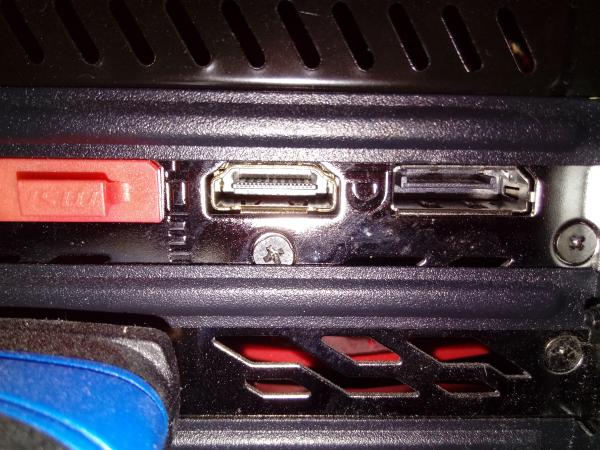There are various connections for connecting a monitor to the computer. VGA, DVI, HDMI, DP - these are all abbreviations that are probably more confusing than helpful at first. The most common connections today include DisplayPort (DP) and HDMI.
HDMI and DisplayPort - which one is right for me?
Pretty much every computer has an HDMI port. Image and sound can be transmitted via this via HDMI cable. Many modern graphics cards, especially in the gaming sector, have a DisplayPort connection in addition to HDMI. This can also transmit picture and sound, even in better quality than HDMI. Both cables are used to transfer data between the computer and the monitor..
 Here you can see an HDMI connection (center) and a DisplayPort connection (right). On the far left is also a DisplayPort connection, but with a protective cap.
Here you can see an HDMI connection (center) and a DisplayPort connection (right). On the far left is also a DisplayPort connection, but with a protective cap. However, there are some differences. The first difference is, of course, in the connection. Even if the connectors look a bit similar and can do the same thing, there are some subtleties. The second difference can be found in the transfer rate: Frequencies of 144 Hz or more are desired, especially in the gaming sector. This frequency basically indicates how fast the image signal is transmitted from the computer to the monitor. The higher the frequency, the better the transmission. HDMI 2.0 cables are basically able to transmit 144 Hz. In some cases, however, this is not possible due to technical restrictions on the part of the manufacturer. DisplayPort cables generally transmit such a high number of frequencies and can even transmit up to 240 Hz or more. In this context, there is also another function:The sync programs of some graphics card providers can be used via DisplayPort. For example G-Sync from NVIDIA or Freesync from AMD. This software ensures that the image transmission and input work together even better, so that the optimal gaming experience can be generated.
Here, however, the question arises: do I really need this? If you use your computer mainly for office or work, such a high frequency is hardly necessary. Whether the letter appears on the screen a fraction of a second faster in Word will make no difference to your work. But if you want to use your computer as a gaming machine, a higher frequency can make a difference. The fraction of a second can mean the difference between victory and defeat in a shooter, for example..
Data transfer rate
Another difference is the data transfer rate. The maximum transfer rate for HDMI cables depends on the type. The old HDMI cables with HDMI 1.4 have a maximum transfer rate of 10.2 GBit / s. HDMI 2.0 looks a bit better at 18 Gbit / s - and HDMI 2.1 is even further ahead with a whopping 38.4 Gbit / s. There are also two versions of the DisplayPort, namely 1.3 and 1.4. DP 1.3 has a transfer rate of 25.9 GBit / s, DisPlayPort 1.4 brings it to 32.4 GBit / s. The latest versions of both types of cable do not take much.
Color depth It
becomes interesting with the color depth. HDMI cables can provide 48 bits per pixel, while the display port only has 30 bits per pixel. So if you have a lot to do with color display, you should give preference to an HDMI connection. This can be important for digital artistic activities or also for photography processing. In terms of resolution, the two cables don't differ much. The latest versions, i.e. HDMI 2.1 and DisplayPort 4, can both display a resolution in 8K. Older HDMI cables cannot do this. HDMI 2.0 can display up to 4K and HDMI 1.4 full HD..
Ethernet
A small advantage of HDMI cables: These can be combined with Ethernet. This gives you the advantage that when a device is switched on, the device connected via HDMI is also switched on. This makes no difference on the computer and monitor, but on the television and game console, for example. In this case, all you have to do is turn on the console and the TV will come on right away.
Conclusion
Ultimately, it can be said that both cable types are very similar. An HDMI cable is actually always sufficient for "home use". DisplayPort actually only unfolds its full effect when it is used in a gaming setup. If you would like to use one of the two connections, but your other device does not have the right plug, adapters for both formats are also available in stores.
By the way: In addition to DisplayPort, there is also the Mini DisplayPort developed by Apple. This is practically the same range of functions, only with a smaller connector.